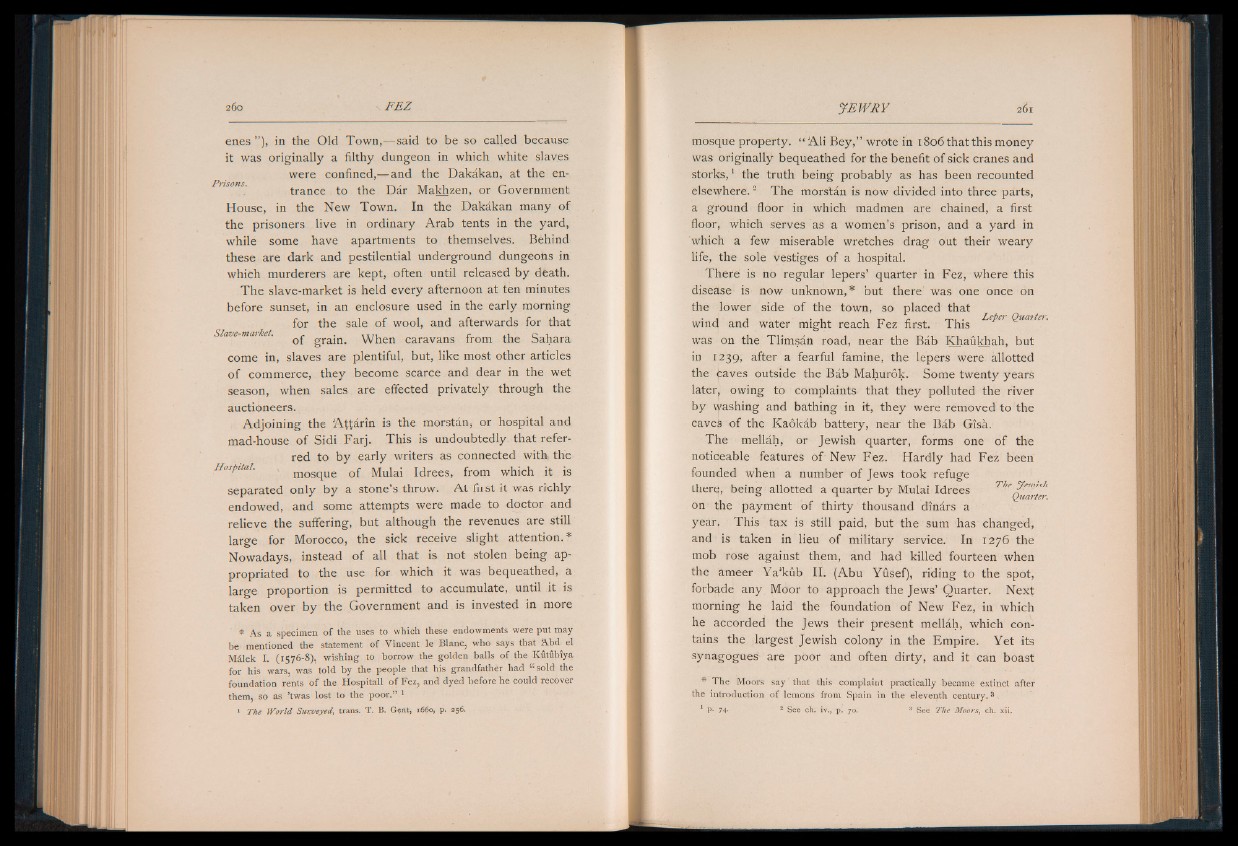
enes ” ), in the Old Town,— said to be so called because
it was originally a filthy dungeon in which white slaves
were confined,— and the Dakakan, at the entrance
to the Dar Makhzen, or Government
House, in the New Town. In the Dakakan many of
the prisoners live in ordinary Arab tents in the yard,
while some have apartments to themselves. Behind
these are dark and pestilential underground dungeons in
which murderers are kept, often until released by death.
The slave-market is held every afternoon at ten minutes
before sunset, in an enclosure used in the early morning
for the sale of wool, and afterwards for that
Slave-market. _ . . . . r , e i_ of gram. When caravans from the .Sahara
come in, slaves are plentiful, but, like most other articles
o f commerce, they become scarce and dear in the wet
season, when sales are effected privately through the
auctioneers.
Adjoining the Attarin is the morstan, or hospital and
mad-house of Sidi Farj. This is undoubtedly that referred
to by early writers as connected with the
Hospttal. mosque of Mulai Idrees, from which it is
separated only by a stone’s throw. At first it was richly
endowed, and some attempts were made to doctor and
relieve the suffering, but although the revenues are still
large for Morocco, the sick receive slight attention.*
Nowadays, instead of all that is not stolen being appropriated
to the use for which it was bequeathed, a
large proportion is permitted to accumulate, until it is
taken over by the Government and is invested in more
* As a specimen of the uses to which these endowments were put may
be mentioned the statement of Vincent le Blanc, who says that Abd el
Malek I. (1576-8), wishing to borrow the golden balls of the Kutubiya
for his wars, was told by the people that his grandfather had “ sold the
foundation rents of the Hospitall of Fez, and dyed before he could recover
them, so as ’twas lost to the poor.” 1
1 The World Surveyed, trans. T . B. Gent, 1660, p. 256.
mosque property. “ A li Bey,” wrote in 1806 that this money
was originally bequeathed for the benefit of sick cranes and
storks,1 the truth being probably as has been recounted
elsewhere.3 The morstan is now divided into three parts,
a ground floor in which madmen are chained, a first
floor, which serves as a women’s prison, and a yard in
which a few miserable wretches drag out their weary
life, the sole vestiges of a hospital.
There is no regular lepers’ quarter in Fez, where this
disease is now unknown,* but there was one once on
the lower side of the town, so placed that
wind and water might reach Fez first. This Qua',teu
was on the Tlimsan road, near the Bab Khaukhah, but
in 1239, after a fearful famine, the lepers were allotted
the £aves outside the Bab Mahurok. Some twenty years
later, owing to complaints that they polluted the river
by gashing and bathing in it, they were removed to the
cavefe of the Kaokab battery, near the Bab Gisa.
The mellah, or Jewish quarter, forms one of the
noticeable features of New Fez. Hardly had Fez been
founded when a number of Jews took refuge
there, being allotted a quarter by Mulai Idrees Quarter
on the payment of thirty thousand dinars a
year. This tax is still paid, but the sum has changed,
and is taken in lieu of military service. In 1276 the
mob rose against them, and had killed fourteen when
the ameer Y a ’kub II. (Abu Yusef), riding to the spot,
forbade any Moor to approach the Jews’ Quarter. Next
morning he laid the foundation of New Fez, in which
he accorded the Jews their present mellah, which contains
the largest Jewish colony in the Empire. Yet its
synagogues are poor and often dirty, and it can boast
* The Moors say that this complaint practically became extinct after
the introduction of lemons from Spain in the eleventh century. 3
1 P* 74* 2 See ch. iv., p. 70. ■ 3 See The Moors, ch. xii.